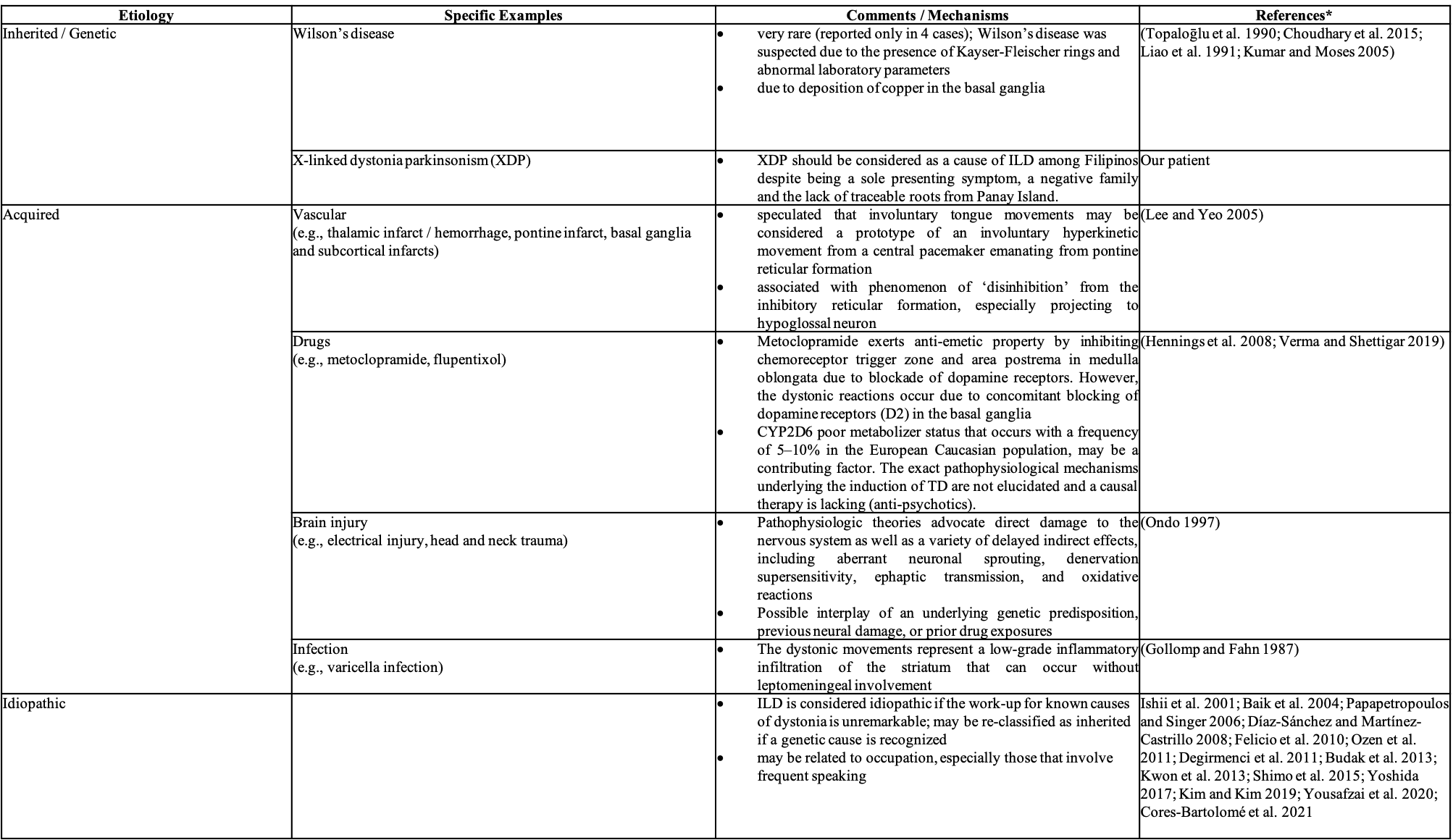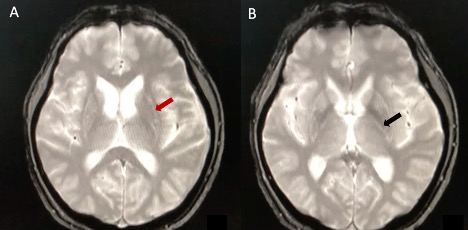Objective: This report aims to describe a 43-year-old Filipino male with ILD aggravated by speech and swallowing. This paper highlights the importance of including XDP as a cause of ILD among Filipinos despite not coming from Panay Island and an unremarkable family history.
Background: Dystonia is generally an involuntary, repetitive muscular contractions occurring elsewhere in the body. Oromandibular dystonia, a form of focal dystonia, involves the muscles of the face, jaw and or tongue. Isolated lingual dystonia (ILD), a rare subtype of oromandibular dystonia, affects only the tongue. Causes of ILD are elucidated in different literatures and case reports [table1]. However, there is paucity of information regarding genetic causes of the movement disorder. This case report highlights XDP as the cause of ILD as confirmed by the presence of XDP-causing mutation.
Method: Case: A 43-year-old male sought medical attention due to involuntary tongue movements aggravated by jaw opening. His concern resulted in speech and swallowing difficulties with consequent weight loss. He was not maintained on any medications. He has no comorbid illnesses. There were no antecedent events and family history of movement disorders documented. Despite a thorough history, clinical examination and work-up, no cause could be identified. Thus, idiopathic isolated lingual dystonia was initially considered. A trial of clonazepam and zolpidem failed to produce favorable response. Trihexyphenidyl, an oral anti-cholinergic, showed gradual improvement in speech and swallowing difficulties. On cranial MRI, there were hyperintensities noted on both putamen and globus pallidus [figure1].
Results: Genetic testing revealed the presence of the X-linked dystonia parkinsonism (XDP, DYT/PARK-TAF1)-causing mutation, the SINE-VNTR-Alu (SVA) retrotransposon insertion in the TAF1 gene.
Conclusion: X-linked dystonia parkinsonism (XDP) should be considered in the differential diagnoses of a patient with isolated lingual dystonia (ILD), even in the face of a negative ancestral roots from Panay. An exhaustive history taking, focused physical examination and relevant diagnostic tests should be carried out before pursuing genetic studies to confirm XDP diagnosis.
References: [1] A. Albanese, K. Bhatia, S.B. Bressman, M.R. Delong, S. Fahn, V.S.C. Fung, M. Hallett, J. Jankovic, H.A. Jinnah, C. Klein, A.E. Lang, J.W. Mink, J.K. Teller, Phenomenology and classification of dystonia: a consensus update, Mov Disord. 28 (2013) 863–873. https://doi.org/10.1002/mds.25475.
[2] T.D. Steeves, L. Day, J. Dykeman, N. Jette, T. Pringsheim, The prevalence of primary dystonia: a systematic review and meta-analysis, Mov Disord. 27 (2012) 1789–1796. https://doi.org/10.1002/mds.25244.
[3] K. Yoshida, Botulinum Neurotoxin Therapy for Lingual Dystonia Using an Individualized Injection Method Based on Clinical Features, Toxins (Basel). 11 (2019) E51. https://doi.org/10.3390/toxins11010051.
[4] M.G. Pauly, M. Ruiz López, A. Westenberger, G. Saranza, N. Brüggemann, A. Weissbach, R.L. Rosales, C.C. Diesta, R.D.G. Jamora, C.J. Reyes, H. Madoev, S. Petkovic, L.J. Ozelius, C. Klein, A. Domingo, Expanding Data Collection for the MDSGene Database: X-linked Dystonia-Parkinsonism as Use Case Example, Mov Disord. 35 (2020) 1933–1938. https://doi.org/10.1002/mds.28289.
[5] S. Makino, R. Kaji, S. Ando, M. Tomizawa, K. Yasuno, S. Goto, S. Matsumoto, M.D. Tabuena, E. Maranon, M. Dantes, L.V. Lee, K. Ogasawara, I. Tooyama, H. Akatsu, M. Nishimura, G. Tamiya, Reduced neuron-specific expression of the TAF1 gene is associated with X-linked dystonia-parkinsonism, Am J Hum Genet. 80 (2007) 393–406. https://doi.org/10.1086/512129.
[6] D.C. Bragg, K. Mangkalaphiban, C.A. Vaine, N.J. Kulkarni, D. Shin, R. Yadav, J. Dhakal, M.-L. Ton, A. Cheng, C.T. Russo, M. Ang, P. Acuña, C. Go, T.N. Franceour, T. Multhaupt-Buell, N. Ito, U. Müller, W.T. Hendriks, X.O. Breakefield, N. Sharma, L.J. Ozelius, Disease onset in X-linked dystonia-parkinsonism correlates with expansion of a hexameric repeat within an SVA retrotransposon in TAF1, Proc Natl Acad Sci U S A. 114 (2017) E11020–E11028. https://doi.org/10.1073/pnas.1712526114.
[7] A. Westenberger, C.J. Reyes, G. Saranza, V. Dobricic, H. Hanssen, A. Domingo, B.-H. Laabs, S. Schaake, J. Pozojevic, A. Rakovic, K. Grütz, K. Begemann, U. Walter, D. Dressler, P. Bauer, A. Rolfs, A. Münchau, F.J. Kaiser, L.J. Ozelius, R.D. Jamora, R.L. Rosales, C.C.E. Diesta, K. Lohmann, I.R. König, N. Brüggemann, C. Klein, A hexanucleotide repeat modifies expressivity of X-linked dystonia parkinsonism, Ann Neurol. 85 (2019) 812–822. https://doi.org/10.1002/ana.25488.
[8] H. Hanssen, M. Heldmann, J. Prasuhn, V. Tronnier, D. Rasche, C.C. Diesta, A. Domingo, R.L. Rosales, R.D. Jamora, C. Klein, T.F. Münte, N. Brüggemann, Basal ganglia and cerebellar pathology in X-linked dystonia-parkinsonism, Brain. 141 (2018) 2995–3008. https://doi.org/10.1093/brain/awy222.
[9] A. Weissbach, G. Saranza, A. Domingo, Combined dystonias: clinical and genetic updates, J Neural Transm (Vienna). 128 (2021) 417–429. https://doi.org/10.1007/s00702-020-02269-w.
[10] R.D.G. Jamora, C.C.E. Diesta, P.M.D. Pasco, L.V. Lee, Oral pharmacological treatment of X-linked dystonia parkinsonism: successes and failures, Int J Neurosci. 121 Suppl 1 (2011) 18–21. https://doi.org/10.3109/00207454.2010.544433.
To cite this abstract in AMA style:
D. Dakay, G. Saranza, Z. Leonardo, C. Klein, N. Brüggemann, A. Westenberger. X-Linked Dystonia Parkinsonism as the cause of Isolated Lingual Dystonia (ILD) [abstract]. Mov Disord. 2022; 37 (suppl 2). https://www.mdsabstracts.org/abstract/x-linked-dystonia-parkinsonism-as-the-cause-of-isolated-lingual-dystonia-ild/. Accessed March 31, 2025.« Back to 2022 International Congress
MDS Abstracts - https://www.mdsabstracts.org/abstract/x-linked-dystonia-parkinsonism-as-the-cause-of-isolated-lingual-dystonia-ild/


